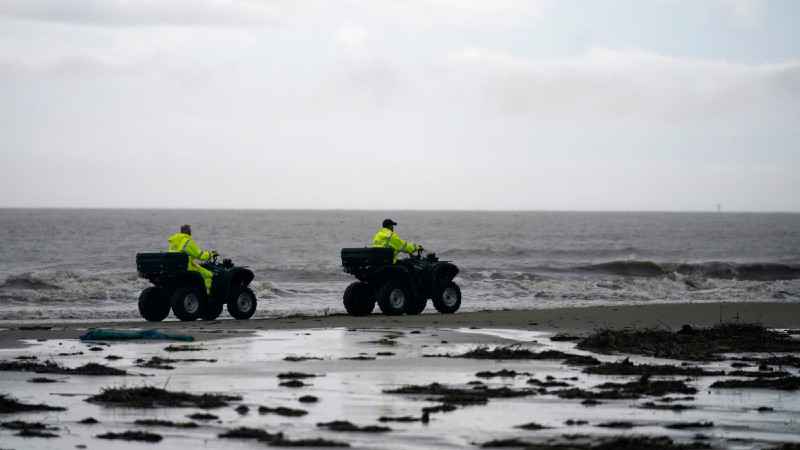Weather delays divers from searching for shipwreck survivors

Lafourche Parish deputies patrol along the shoreline of the Gulf of Mexico, not far from where a lift boat capsized during a storm on Tuesday, killing one with 12 others still missing, on Elmer's Island, La., Thursday, April 15, 2021.[AP Photo/Gerald Herbert]
Families anxiously awaited news of the 12 people missing from a capsized oil industry vessel Thursday while stormy weather delayed divers from reaching the ship to search for survivors.
Coast Guard Petty Officer 2nd Class Jonathan Lally said rescuers don’t know whether any of the missing might be caught inside the lift boat that flipped over Tuesday in hurricane-force winds and high seas off the Louisiana coast.
“There is the potential they are still there, but we don’t know,” Lally said early Thursday. “We’re still searching for 12 people because there are 12 still missing.”
The Coast Guard expects the divers to make it to the vessel Thursday but wants to ensure the rescuers won’t need rescuing themselves, he said.
“With something like this, that is a vessel that is capsized with the potential of people trapped inside, there are a lot of dynamic aspects we have to look at,” Lally said.
Coast Guard search: 1 dead, 12 missing in ship capsize off Louisiana
Six people from the Seacor Power were rescued alive and one person’s body was recovered from the Gulf of Mexico on Wednesday as searchers scanned an area larger than the state of Rhode Island. The Lafourche Parish Coroner’s Office identified the person found dead as David Ledet, 63, of Thibodaux.
Part of the overturned ship’s hull and one of its legs were still visible, leaving most of the bulky vessel underwater, in an area 50 to 55 feet (15 to 17 meters) deep, according to the Coast Guard. Also called a jackup rig, it has three long legs designed to reach the sea floor and lift it out of water as an offshore platform.
Despite a widening search, no other crew members have been spotted.
“We had both air and surface assets out last night — nothing materially has changed,” U.S. Coast Guard Petty Officer Third Class John Michelli said early Thursday.
Authorities used all-terrain vehicles to search the shoreline near Port Fourchon, a major base for the U.S. oil and gas industry, but paused for impending storms that caused the National Weather Service to issue a flash flood warning for the area.
Lafourche Parish asked its residents to pause for a moment of silence for the mariners aboard the Seacor Power at 4 p.m., around the time the first distress calls were received.
“There are some local guys that are on that vessel,” Lafourche Parish President Archie P. Chaisson III said. “It’s a very tight community in that industry. Those crews are very tight. This crew had apparently been around for a while working together.”
Marion Cuyler, the fiancée of crane operator Chaz Morales, was waiting with family of other missing workers at a Port Fourchon fire station Wednesday near a landing site where helicopters were coming and going. She said she talked to her fiancé before he left Tuesday.
“He said that they were jacking down and they were about to head out, and I’m like, ‘The weather’s too bad. You need to come home.’ And he’s like, ‘I wish I could.’”
She said she hopes her fiancé made it to an air-locked part of the lift boat and is able to hold on until rescuers can reach him.
The vulnerabilities of lift boats in storms have been known for years, and federal authorities have investigated multiple deaths on them.
In September 2011, large waves struck the hull of the Trinity II in the Gulf of Mexico, breaking one of its giant legs, and the stern collapsed into the water, the National Transportation Safety Board wrote in its report. Four of the 10 people on board perished.
In July 1989, the lift boat AVCO V sank off the coast of Leeville, Louisiana, in storms associated with Hurricane Chantal. Waves shifted equipment on the deck, prompting the vessel to capsize and sink, the NTSB found. Ten of the 14 people on board died.
Coast Guard Capt. Will Watson said winds were 80 to 90 mph (130 to 145 kph) and waves rose 7 to 9 feet high (2.1 to 2.7 meters) when the Seacor Power overturned.
“That’s challenging under any circumstance,” Watson said at a Wednesday news conference. “We don’t know the degree to which that contributed to what happened, but we do know those are challenging conditions to be out in the maritime environment.”
The National Weather Service in New Orleans issued a special marine warning before 4 p.m. Tuesday that predicted steep waves and winds greater than 50 knots (58 mph).
Weather service meteorologist Phil Grigsby said the system was an offshore derecho — or straight-winds storm. He said the weather service’s nearest official gauge, at Grand Isle, showed about 30 minutes of 75 mph (120 km/h) winds, followed by hours of winds over 50 mph (80 km/h).